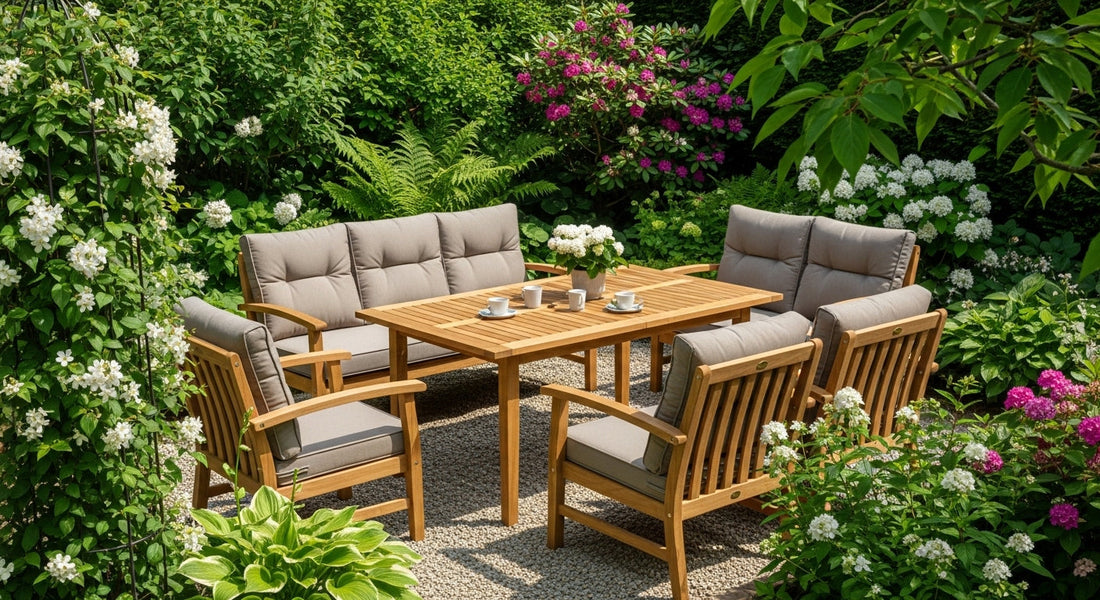
Outdoor Furniture Guide: How to Choose the Right Materials for Your Climate
Share

Choosing outdoor furniture is an exciting step in creating your personal backyard oasis, but it's an investment you want to last beyond one season. While the look and style of a patio set are what first catch your eye, the material it's made from is the single most important decision for ensuring its longevity. The best outdoor furniture material for your home depends entirely on your local climate. A chair that thrives in a dry, sunny desert climate might quickly fail in a rainy, humid one. Matching your furniture materials to your weather conditions is the key to creating a beautiful outdoor space that lasts for many seasons to come.
A Breakdown of Common Materials: Pros & Cons
Understanding the strengths and weaknesses of each material will help you make an informed choice.
A. Natural Wood (Teak, Acacia, Cedar)
-
Pros: Wood offers a timeless, natural beauty that blends seamlessly into any garden. Teak is the king of outdoor woods; its high natural oil content makes it incredibly resistant to rot, water, and insects.
-
Cons: It requires the most maintenance. To maintain its original honey-brown color, it needs to be regularly cleaned and sealed or oiled. If left untreated, teak will weather to a silvery-gray patina, which many people find beautiful.
-
Best For: Most climates, but requires a commitment to maintenance.
B. All-Weather Wicker (Resin Wicker)
-
Pros: This material provides the classic, cozy look of natural wicker but is woven from a durable synthetic resin over a rustproof aluminum frame. This makes it highly weather resistant patio furniture, standing up to moisture, UV rays, and salt air. The teak vs wicker furniture debate often comes down to this low-maintenance durability.
-
Cons: Quality varies greatly. Cheaper resin can become brittle and crack in direct sun or freezing temperatures over time.
-
Best For: Humid, rainy climates and coastal areas.
C. Metal (Aluminum, Wrought Iron)
-
Pros: Aluminum is the most popular choice for modern outdoor furniture because it's lightweight, strong, and will not rust. Wrought iron is extremely heavy and sturdy, making it perfect for windy locations.
-
Cons: Metal can get very hot in direct sun. Wrought iron is heavy to move and is prone to rust if the protective coating is chipped, requiring regular touch-ups.
-
Best For: Aluminum is a great all-rounder for any climate. Wrought iron is best for drier, windy climates.
D. Recycled Plastic (HDPE, Polywood)
-
Pros: Made from recycled plastics like milk jugs, High-Density Polyethylene (HDPE) lumber is virtually indestructible. It's heavy, comes in a huge variety of colors, is fade-resistant, and requires no maintenance beyond simple cleaning.
-
Cons: It can be more expensive upfront than other materials and lacks the natural look of wood.
-
Best For: Any climate imaginable. It's the top choice for extreme conditions, from scorching sun and heavy rain to freezing snow and salty coastal air.
Don't Forget the Fabric: Cushion Considerations
The frame is only half the battle; the cushions need to be just as durable as the furniture itself.
-
Fade Resistance: The gold standard for outdoor fabric is solution-dyed acrylic, with brands like Sunbrella leading the market. In this process, the color is added to the liquid acrylic solution before it's spun into yarn, making the color part of the fiber itself. This makes it incredibly resistant to fading from UV exposure.
-
Moisture Management: Look for cushions filled with quick-dry foam, which has an open-cell structure that allows water to pass through easily instead of being absorbed. Even with the best materials, it's always smart to store cushions in a deck box or indoors during heavy rain or the off-season to learn how to protect outdoor furniture and prolong its life.
A Simple Care Chart for Each Material
|
Material |
Cleaning |
Protection |
|---|---|---|
|
Wood (Teak) |
Mild soap & water. |
Annual sealing/oiling to maintain color. |
|
Wicker (Resin) |
Hose down, soft brush. |
Cover in freezing temps to prevent cracking. |
|
Aluminum |
Mild soap & water. |
No protection needed. |
|
Recycled Plastic |
Soap & water, power wash on low. |
No protection needed. |
Conclusion: Making a Stylish and Durable Choice
Investing in high-quality outdoor furniture made from a material suited to your specific climate is the key to creating an outdoor oasis you can enjoy for years, not just a single summer. By understanding the pros and cons of each material and committing to a simple maintenance routine, you can ensure your patio furniture remains a beautiful and functional part of your home for many seasons to come.
